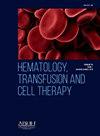Characteristics of the post-surgical decrease in platelet counts in orthopedic surgery patients, observations and insights
IF 1.8
Q3 HEMATOLOGY
引用次数: 0
Abstract
Introduction
A reduced platelet count (PLT) is a frequent post-operative finding in orthopedic surgery patients. Despite its prevalence, the characteristics of post-surgical thrombocytopenia have not been well described.
Methods
A retrospective chart review was conducted on patients who underwent a knee or hip replacement from 2012 to 2015. Patients who received heparin were excluded.
Results
A total of 56 patients were analyzed on post-operative days 0 to 4. By day 1, 90.9% of the patients experienced a reduction in their platelet counts. The lowest mean platelet count (nadir) occurred on day 2 (201.3 × 109/L). The average decrease in the platelet count from the baseline was 24% (95%CI: 20.6 - 27.2). The change in the platelet count from the baseline ranged from a 49.6% drop to a 14.2% increase. A substantial portion of patients experienced thrombocytopenia, with 28% occurring on day 2. Platelet counts less than 100 × 109/L occurred only once. The percent decrease in the platelet count from the baseline to any other time point was significantly larger in patients aged > 65 years, compared to patients aged ≤ 65 years (p = 0.007). Specifically, the average drop in the platelet count at the nadir (day 2) relative to the baseline was 27.8% in patients aged > 65 years, compared to 19.5% in patients aged ≤ 65 years.
Conclusions
A reduction in the platelet count is a frequent post-operative finding in orthopedic surgery patients, even after removing confounding factors, such as heparin exposure, but clinical thrombocytopenia is uncommon. Alternative etiologies should be considered when the platelet count is less than 100 × 109/L. Vigilance should also be considered regarding elderly patients.
骨科手术患者术后血小板计数下降的特点、观察与体会
血小板计数降低(PLT)是骨科手术患者术后常见的发现。尽管其流行,术后血小板减少症的特点尚未得到很好的描述。方法回顾性分析2012 - 2015年行膝关节或髋关节置换术的患者。排除了接受肝素治疗的患者。结果术后0 ~ 4天共分析56例患者。到第1天,90.9%的患者血小板计数下降。平均血小板计数最低(最低点)发生在第2天(201.3 × 109/L)。血小板计数较基线平均下降24% (95%CI: 20.6 - 27.2)。血小板计数的变化从基线下降49.6%到增加14.2%不等。很大一部分患者出现血小板减少,28%发生在第2天。血小板计数小于100 × 109/L仅1例。血小板计数从基线到任何其他时间点的下降百分比在年龄和年龄的患者中明显更大;65岁,与≤65岁的患者相比(p = 0.007)。具体来说,在年龄为18岁的患者中,血小板计数在最低点(第2天)相对于基线的平均下降幅度为27.8%;65岁,而年龄≤65岁的患者为19.5%。结论:即使排除肝素暴露等混杂因素后,骨科手术患者术后血小板计数减少也是常见的,但临床血小板减少并不常见。当血小板计数小于100 × 109/L时,应考虑其他病因。老年患者也应提高警惕。
本文章由计算机程序翻译,如有差异,请以英文原文为准。
求助全文
约1分钟内获得全文
求助全文
来源期刊

Hematology, Transfusion and Cell Therapy
Multiple-
CiteScore
2.40
自引率
4.80%
发文量
1419
审稿时长
30 weeks
 求助内容:
求助内容: 应助结果提醒方式:
应助结果提醒方式:


